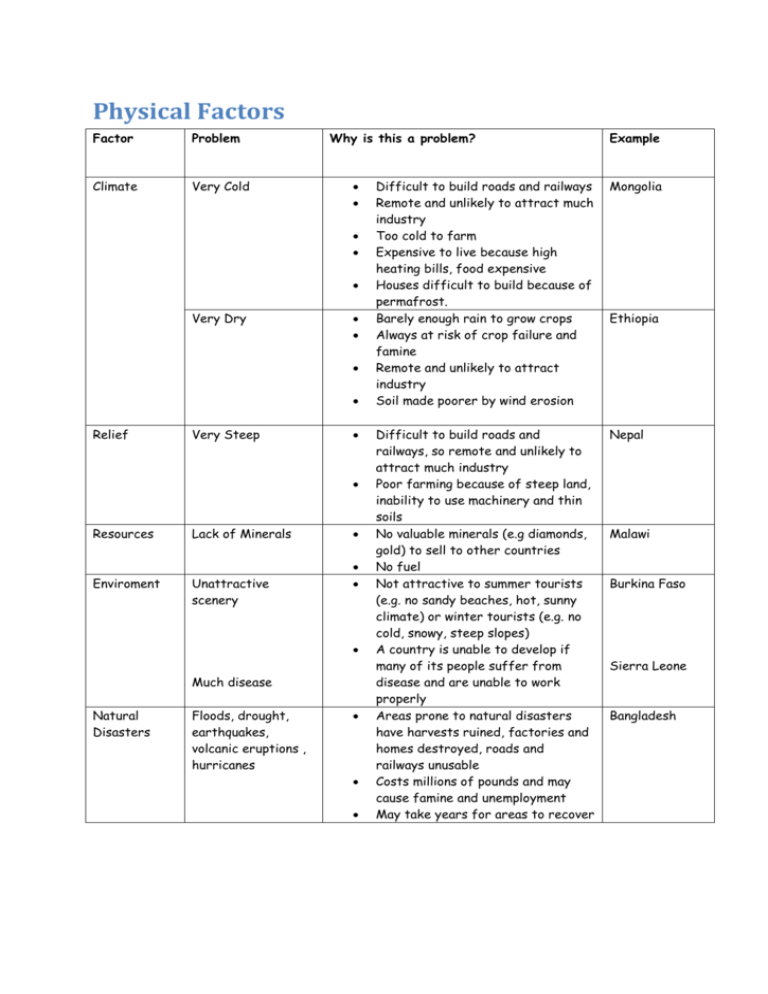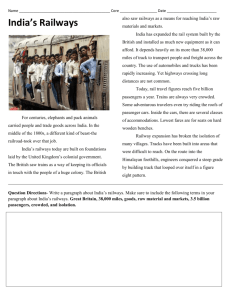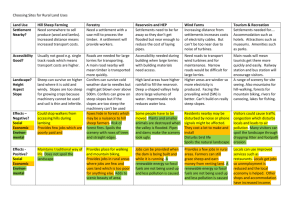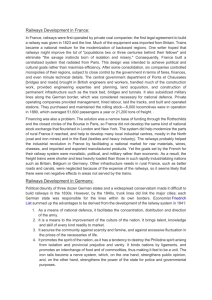File
advertisement

Physical Factors Factor Problem Climate Very Cold Why is this a problem? Very Dry Relief Very Steep Resources Enviroment Lack of Minerals Unattractive scenery Much disease Natural Disasters Floods, drought, earthquakes, volcanic eruptions , hurricanes Example Difficult to build roads and railways Remote and unlikely to attract much industry Too cold to farm Expensive to live because high heating bills, food expensive Houses difficult to build because of permafrost. Barely enough rain to grow crops Always at risk of crop failure and famine Remote and unlikely to attract industry Soil made poorer by wind erosion Mongolia Difficult to build roads and railways, so remote and unlikely to attract much industry Poor farming because of steep land, inability to use machinery and thin soils No valuable minerals (e.g diamonds, gold) to sell to other countries No fuel Not attractive to summer tourists (e.g. no sandy beaches, hot, sunny climate) or winter tourists (e.g. no cold, snowy, steep slopes) A country is unable to develop if many of its people suffer from disease and are unable to work properly Areas prone to natural disasters have harvests ruined, factories and homes destroyed, roads and railways unusable Costs millions of pounds and may cause famine and unemployment May take years for areas to recover Nepal Ethiopia Malawi Burkina Faso Sierra Leone Bangladesh Social and Physical Factors which Influence Population Density 1.Climate People prefer to live where there is rain throughout the year and no extremes of temperature (e.g. north-west Europe). In some areas, the climate limits the number of people who can live there. Few people live where the climate is very cold ( e.g. northern Russia). The living conditions are unpleasant and expensive. The growing season is too short for crops to grow, so all food has to be important. It is difficult to build on ground that is frozen in winter but very muddy in summer. Transport by road, rail and water is hazardous in winter and the remoteness of these regions means few industries set up here. This means that unemployment is high. Also, few people live where there is little rain ( e.g. the middle of Australia). Again, the conditions are unpleasant and it is difficult to grow crops. The soil is often thin and poor because it is easily eroded by the wind. 2.Soil Some river valleys are very crowded (e.g. Nile Valley, Ganges Valley). The soil here is fertile alluvium, so it is possible to grow a lot of food in a small area. This means that farms are small. The valley is also flat and the river provides people with a reliable allyear water supply. Areas with poor soils are sparsely populated, as the farms need to be very large (e.g. the Amazon Basin). 3.Relief People prefer to live in flat, lowland areas. Most mountain ranges in the world are areas of low population density (e.g. the Himalayas). This is partly because they are cold and their soils are thin. It is also because the slopes are steep, which makes it difficult to build houses, roads and railways, which in turn makes them unattractive for industry. 4.Resources Where the environment provides useful resources, the population density is higher. Large deposits of minerals, especially coal, have attracted people because of many employment opportunities (e.g. north-east USA). Other natural resources include attractive scenery, which encourages tourists so people go to work even retire there (e.g California). 5.Communications Areas where there are many roads, railways, airports and ports are more crowded ( e.g. north-west Europe). These areas attract industry, which gives many employment opportunities. On the other hand, remote areas deter people (e.g. northern Canada). 6. Technological Development Countries with a lot of natural resources are nor crowded if they do no have the money and skills to exploit their resources ( e.g. Democratic Republic of the Congo). Countries with advanced technologies and well-educated people can support higher population densities (e.g. Japan). 7. Economic activities Regions where the main activity is industry or services have high population densities (e.g. south-east Australia). Large numbers of people can be employed in a small area. Conversely, it takes a large area of land to support people who are farming, especially if the farms are large (e.g Great Plains, USA).











